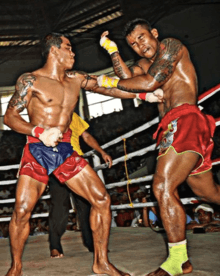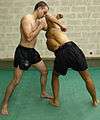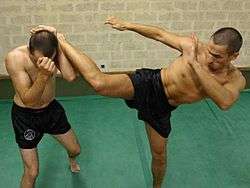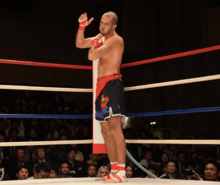Lethwei
 | |
| Also known as | Burmese Bare knuckle Boxing, Myanmar Traditional Boxing, Bando Kickboxing, The Art of 9 Limbs |
|---|---|
| Focus | Striking |
| Hardness | Full-contact |
| Country of origin |
|
| Famous practitioners | Kyar Ba Nyein, Dave Leduc, Too Too, Tun Tun Min, Saw Nga Man, Nilar Win, Win Tun, Tway Ma Shaung, Lone Chaw, Shwe Wah Tun, Saw Gaw Mu Doe, Soe Lin Oo, U Bo Sein, Phyan Thwe, |
Lethwei (Burmese: လက်ဝှေ့; IPA: [lɛʔ.ʍḛ]) or Burmese bareknuckle boxing is a full contact combat sport from Myanmar that uses stand-up striking along with various clinching techniques.[1] Lethwei is considered to be one of the most aggressive and brutal martial arts in the world, because the fighters fight bareknuckle with only the use of tape and gauze on their hands.[2] The use of fists, elbows, knees, and feet, but more surprisingly, the head makes it a very unusual martial art. Although disallowed in many combat sports, in Lethwei, the use of headbutt is encouraged. This is the reason it also known as "The Art of 9 Limbs".[3][4]
It is similar to related styles in other parts of the Indian cultural sphere, namely Muay Thai from Thailand, Pradal Serey from Cambodia, Muay Lao from Laos, Tomoi from Malaysia and Musti-yuddha from India.[5]
History
Records exists of Lethwei matches dating back to the Pyu Empire in Myanmar. Lethwei, along with Bando and its armed sibling Banshay were successfully used by ancient Myanmar armies in many wars against neighboring countries.[6]
In ancient times, matches were held for entertainment and were popular with every strata of society. Participation was opened to any male, whether king or commoner. At that time, matches took place in sandpits instead of rings.[7] Boxers fought without protective equipment, only wrapping their hands in hemp or gauze. There were no draws and no point system—the fight went on until one of the participants was knocked out or could no longer continue. Back then, Burmese boxing champions would enter the ring and call for open challenges.[8]
Traditional matches include Flagship Tournament, which are still fought throughout Myanmar, especially during holidays or celebration festivals like Thingy an.[9][10][11]
Modernization
Establishing rules and regulations
Kyar Ba Nyein, who participated in boxing at the 1952 Summer Olympics, pioneered modern Lethwei by setting in place modern rules and regulations.[12] He travelled around Myanmar, especially the Mon and Karen states, where many of the villagers were still actively practicing Lethwei. Kyar Ba Nyein brought them back to Mandalay and Yangon and, after training with them, encouraged them to compete in matches.[13]
The Myanmar government made some organizational changes to make Burmese boxing more marketable internationally.[14][15][16][17]
In 2016, a new promotion called World Lethwei Championship launched using a modified rule-set. Unlike traditional lethwei events, judges determine a winner if the fight ends without a knockout. There are also no injury time outs.
Attracting foreign fighters
The first international Lethwei event was held in June 2001, when three kickboxers from the USA competed against lethwei practitioners. They were Shannon Ritch, Albert Ramirez and Doug Evans. All three Americans were knocked out in the first round. A revenge match with properly trained American and European fighters well prepared to fight bare-knuckle was cancelled the last minute by Lethwei promoters and the military in 2003. The first international challenge match in 2001 was used as a propaganda tool by the military and television stations and called a disgraceful sham by American and European promoters.
From 10 to 11 July 2004, the second event headlining foreigners took place with four Japanese fighters fighting against Burmese boxers. They were Akitoshi Tamura, Yoshitaro Niimi, Takeharu Yamamoto and Naruji Wakasugi. MMA fighter Tamura, knocked out Aya Bo Sein in the second round and became the first foreigner to beat a lethwei practitioner in an official match.
International matches continued from 2004 all the way until 2016 with the most exciting of them being the Cyrus Washington vs. Tun Tun Min trilogy.
On 16 December 2016, the rematch Dave Leduc and Tun Tun Min took place at the Air KBZ Aung Lan Championship in Yangon, Myanmar. The two previously fought in October to an explosive draw, but the rematch was sweetened by an added bonus: ownership of the Lethwei Open Weight World Championship Belt. Leduc became the first non-Burmese fighter to win the Lethwei Golden Belt after defeating Tun Tun Min in the second round.[18][19][20]
Following his win, Leduc said in an interview ″I have so much vision for this sport. I see Lethwei doing the same for Myanmar as what Muay Thai has done for Thailand."[21]
On April 18, 2017, for his second title defense,[22] Dave Leduc faced Turkish Australian fighter Adem Yilmaz in Tokyo, Japan in traditional Lethwei rules.[23][21][24] The first Lethwei World Title fight headlining two non-burmese in the sport's history. For the occasion, the Ambassador of Myanmar to Japan was present at the event held in the Korakuen Hall.[25]
Techniques
Aside from punches, kicks, elbows and knee attacks, Burmese fighters also make use of head-butts, raking knuckle strikes and take downs.
 Spinning elbow strike
Spinning elbow strike Roundhouse kick
Roundhouse kick Knee and elbow strike
Knee and elbow strike Knee and punch
Knee and punch Jumping knee and elbow
Jumping knee and elbow Back hook kick
Back hook kick
Traditional gesture
Lekkha moun

The lekkha moun is the traditional gesture performed by Lethwei fighters to challenge their opponent with courage and respect. The lekkha moun is done by clapping 3 times with right palm to the triangle shaped hole formed while bending the left arm. The clapping hand must be in form of a cup, while the left hand must be placed under the right armpit. The lekkha moun is done at the beginning of the lethwei yay and can also be done while fighting.
This invitation to fight is inspired from the birds of prey, like the eagle, as they flap their wings when flying and hunting.
Lethwei yay
The Lethwei yay could be described as a fight dance. It is done before the fight and as a victory dance after the fight. The lekkha moun is usually confused with the lethwei yay, but the lekkha moun is performed alongside with Lethwei yay.
 The lai ka
The lai ka Let Khamonghkhat
Let Khamonghkhat
Rules
Rounds
- 5 rounds of 3 minutes
- 2 minutes rest
Permitted techniques
- Head butts
- All punches
- All elbow strikes
- All knee strikes
- All kicks
- Extensive clinching
- Sweeps and throws
The use of the feet, hands, knees, elbows and head is permitted.

Fighting attire
The Burmese bareknuckle boxing rules prohibits the use of gloves.
- The fighters must only wear tape, gauze and electrical tape on their hands and feet.
- The fighters shall wear only shorts, without a shirt or shoes.
- The fighters must wear a groin protector's.
.
- The fighters must wear a gum shield.
The fighters are required to apply the wrapping in front of the fight officials, who will endorse the wraps.
The decision
There is no point system in Lethwei: The only way to win is by knockout or because of an injury and the inability to fight any more. At the end of the match if the two fighters are still standing, the fight is declare a draw. This ensures that the fighters always give their 100% and tries to finish the fight.
- The knock-out (KO) is when the opponent falls on the floors, leans unconscious on the ropes or if the fighter is unable to stand up or defend himself within 20 seconds (10 counts with 1 count/2seconds).
- If there is a count, it must count at least up to 8.
- When 3 counts are performed in a single round, the fight is terminated and scored as knock-out (count limit).
- When 4 counts are performed during the entire duration of the fight, the match is terminated and scored as knock-out (count limit).
- The technical knock-out (TKO) is when the fighter is in a position that can damage or severely harm him if the fight continues. The ring doctor is consulted and he is the one making that decision.
- If there is no KO or TKO until the end of the last round, the fight is declared a draw.
The "injury" time-out
- If a knockout happens, the fighter can take a special two minute time-out to recover and choose whether he wishes to continue the bout. He may do so only once in a fight.[26] The only win is by knockout; there is no point system. If neither fighter wins by knockout then the fight is declared a draw.[11]
- The time-out can't be used in the final fifth round.
- The use of the time-out is considered as 1 count.
The referee
There is one referee that oversees the fight. The referee has the power to :
- End the fight if he considers one fighter to be significantly outclassed by his opponent.
- Stop the fight and refer to the doctor if a fighter is heavily wounded.
- Warn the fighters. He makes sure the fight proceeds fairly and in compliance with the rules.
See also
References
- ↑ Kyaw Zin Hlaing (1 September 2015). "Easy win for Lethwei fighters". Myanmar Times.
- ↑ "Lethwei: The world's most brutal sport". Ugly Chicken. 4 October 2017.
- ↑ Goyder, James (22 July 2015). "Inside a Burmese Lethwei Gym". Fightland Blog (Vice).
- ↑ "Myanmese women show fighting spirit by embracing brutal martial art of Lethwei". South China Morning Post. 19 August 2015.
- ↑ Wikipedia, Source (1 September 2013). "Combat Sports: Boxing, Taekwondo, Judo, Fencing, Sumo, Kendo, Grappling, Kickboxing, Savate, Boxing Training, Paralympic Judo, Brazilian Jiu-Jitsu, Mi". General Books. Retrieved 5 April 2018 – via Google Books.
- ↑ "Lethwei : Myanmar bare knuckle boxing". Full Contact Martial Arts.
- ↑ Giordano, Vincent. "Born Warriors: Fighting for Survival". 15 July 2015.
- ↑ Journal of the Royal Society of Arts, Volume 41. G. Bell and Sons. 1893. p. 151.
At a Burmese boxing match a champion will jump into the ring and dance about, smacking his breast and arms and cracking his fingers, challenging all comers.
- ↑ Giordano, Vincent. "Burmese Lethwei: The Tradition of Child Fighters". Retrieved 2 September 2015.
- ↑ "Women join in Myanmar's ferocious kickboxing". Bangkok Post. 1 April 2016.
- 1 2 Xegarra, Guillermo. "Born Warriors: Documentarian Vincent Giordano Interview Part 2".
- ↑ "Kyar ba nyein". Scribd.com. Retrieved 2015-03-04.
- ↑ Giordano, Vincent. "Born Warriors Redux: A New Era Begins for an Ancient Sport". Retrieved 15 July 2015.
- ↑ Goyder, James (17 December 2014). "The Burmese Kickboxing Style of Lethwei Expands Into Singapore". Vice Fightland).
- ↑ Giordano, Vincent (13 August 2015). "Burmese Lethwei: Bare Knuckle Revival".
- ↑ Calderon, Justin (23 September 2014). "Punches, headbutts, knockouts: Asia's 'new' martial arts sensation". CNN.
- ↑ Olavarria, Pedro (2 December 2014). "Bando: The style of Burmese Martial Arts". Vice Fightland.
- ↑ Kyaw Zin Hlaing (13 December 2016). "Myanmar's lethwei goliath toppled by Canadian 'Dave'". Myanmar Times.
- ↑ "デーブ・レダックチャンピオン Dave Leduc Champion". The Weekly Fight Japan. 12 December 2016.
- ↑ Anthony Da Silva-Casimiro (20 December 2016). "Tout sauf de la chance pour Dave Leduc". La Revue.
- 1 2 Eaton, Matt (18 April 2017). "Embracing tradition: The rise of LethweiI". The Fight Nation.
- ↑ "Weigh ins for Lethwei in Japan 3 GRIT - 明日開催!第3回日本ラウェイ大会『ラウェイinジャパン 3 ~GRIT~』後楽園ホール大会!計量と公開記者会見終了". The Weekly Fight. 17 April 2017.
- ↑ "4・18『Lethwei in Japan 3 ~GRIT~』全対戦7カード発表!ミャンマーvs.日本(4対4)vs.USA(2対2)にカナダの現ラウェイ王者が再参戦!相手は第1回大会参戦のオーストラリア選手! – 週刊ファイト". The Weekly Fight. 3 March 2017.
- ↑ Marcil, Patrick (12 April 2017). "Gatineau Fight Team: Avril en action!". Gatineau Martial Arts.
- ↑ "Lethwei in Japan 3 GRIT" [Lethwei in Japan 3 GRIT is the third tournament is Japan]. Myanma Allin Daily (in Burmese). 21 April 2017.
- ↑ Looi, Florence (8 September 2015). "Myanmar's Lethwei fighters bare their knuckles". Al Jazeera.
Further reading
- Maung Gyi, Burmese bando boxing, Ed. R.Maxwell, Baltimore, 1978
- Zoran Rebac, Traditional Burmese boxing, Ed. Paladin Press, Boulder, 2003
| Wikimedia Commons has media related to Lethwei. |